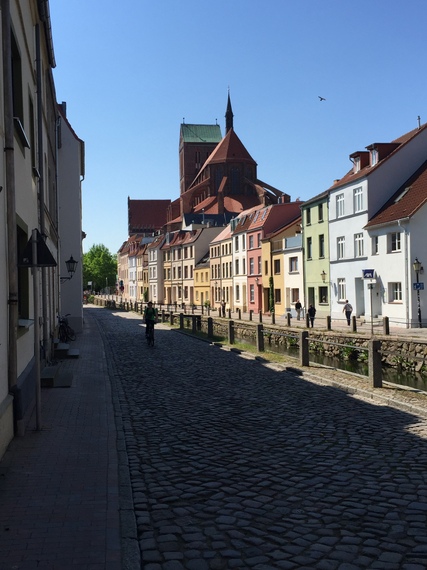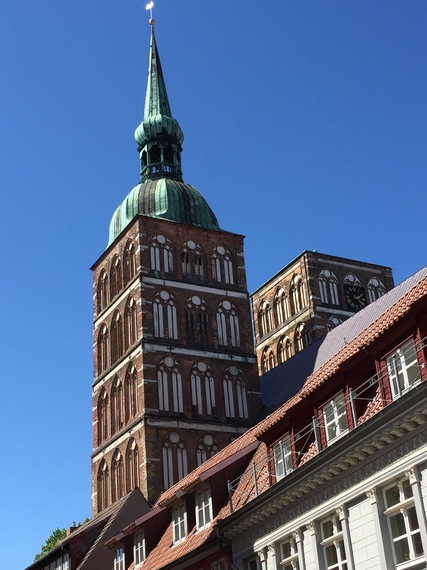We have pirates to blame for the Hanseatic League. It began as an alliance of city states, bonding together to defeat bandits roaming the Baltic. But it soon developed into a confederation of merchant guilds, like a medieval European Union. Between 1400 and 1800, this network of more than 100 Hansa ports and trading posts thrived. Ship-loads of timber, amber, wax, resin, wool, linen, silk, fur and rye shuttled across the chilly and treacherous Baltic.
From Lubeck to Tallin to Bergen, the League expressed its wealth and self-confidence in fine civic spaces adorned by monumental red brick Gothic architecture. Stone wasn't easily available locally, whereas clay could be brought in from the North German Plain. Hansa's burghers pushed brick to its limits, competing to build the tallest towers atop the vastest churches, visible from sea or land.
Inside, slender brick columns soar toward heaven, drawing the eyes of humble worshippers up in awe. During the Reformation most of the cherubs, gold-encrusted carvings and other Catholic bling were stripped out; and few of their stained glass windows survived World War Two, leaving their interior spaces light, airy and pleasingly minimalist. They bring to mind the cool, serene interiors painted by the Dutch masters.
Among the Hanseatic League's most distinguished port cities were Wismar and Stralsund, in the north eastern corner of Germany. Together with nearby Schwerin, the elegant capital of the Grand Dukes of Mecklenburg-Vorpommern, they are being discovered by a new generation from the West who avoided the Soviet-occupied East for forty years.
All three cities -Schwerin, Stralsund and Wismar- were in the zone handed to Stalin at the end of the Second World War, and they suffered the indignity of four decades of neglect under the German Democratic Republic. However, their citizens' misfortune may have been the trio's aesthetic salvation: for all the Eastern Bloc's many faults, it lacked the resources to replace medieval districts with the dismal concrete of post-war North America and Western Europe.
Thousands of half-timbered structures survive throughout what was East Germany. Travelling around the eastern part of the country, many dorfs (villages) still have squat, half-timbered agricultural sheds, or Elizabethan-looking town houses with elaborate inscriptions written across the exterior in Gothic script, their owners flaunting both their piety and their affluence. Since reunification, the Germans have done a remarkable job renovating dozens of historic towns, and they deserve visitors from further afield; its remains a mystery that as one encounters no English-speaking tourists.
When travellers read that a city has an intact central core, they are wise to brace themselves to find two or three fine streets, such as Canterbury or Salisbury in the UK or Santa Fe or New Orleans in the States. But in Schwerin, Stralsund and Wismar, there are miles of cobbled roads, lined with half-timbered or Renaissance houses. It is a pleasure to stroll their broad avenues and narrow alleys, dipping into churches or courtyards of alms houses, and stopping at a pavement cafe to enjoy the devastating ice cream sundaes the Germans have perfected.
Arguable, Teutonic sundaes deserve their own UNESCO listing, but Wismar has surely earned its recognition on the list of world heritage sites. From the railway station one follows a pretty canal, lined by eighteenth century town houses, to the church of St Nikolai. Begun in 1270, it is a Gothic masterpiece in red brick, with white decorative exterior tiles used like basket work. Inside, one vast wall is painted with the breath-taking Tree of Jesse, and another with The Man of Sorrows ("ecco homo"). However, the church is no museum piece; it became the heart of local political protest in 1989 as East Germans rose up against their Communist masters.
From St Nikolai, the canal leads to the town walls and a celebrated gateway which frames the port and the Baltic beyond. Enormous brick warehouses stand empty on the quay, waiting for someone to convert them into lofts. Also leading to the port is Spiegelberg Strasse, a broad avenue of Renaissance gems.
So authentically medieval is Wismar that the German director FW Murnau filmed his 1922 horror classic Nosferatu there, as did Werner Herzog, when he remade it in 1979. (Hitchcock credited Murnau as his greatest influence).
Wismar's main square is lined by tall, thin houses with Dutch stepped gables, one of which is Alte Schwede (Old Swede) - Wismar was part of the Swedish empire from the Peace of Westfalia (1648) until 1903. The most unusual structure, though, is in a quiet side street: the Heiligen Geist Kirche (Holy Ghost Church), built in the 15th Century as a hospital. The rectangular interior has an extravagantly-painted wooden ceiling, depicting Old Testament scenes in innocently naive style, and a portrait of Martin Luther with a swan. Here, the town's sickly citizens received spiritual and medical help. But today, instead of wan, bearded men in tights and lace collars, there is a cafe selling fairly traded tea and coffee in the 21st Century Protestant manner.
Stralsund is another UNESCO world heritage site, bristling with atmospheric cobbled streets. The town is surrounded by lakes and the Baltic on every side, giving it the feel of a peninsula. The interior of St Nikolaikirche, a monumental 13th century building, provides a glimpse of how churches looked when their columns, arches, apses, vaults and walls were busily decorated. It is attached to a no-nonsense red brick Gothic Rathaus (town hall) projecting the power of its burghers onto the Altmarkt (old market) before it.
The nearby new market boasts a square surrounded by Renaissance buildings, as well as a superb art nouveau house. By the Marienkirche is a more recent slice of history: a graveyard and memorial to the Soviet soldiers who died liberating the town from the Third Reich. As with Wismar, the town's old quarter is extensive, with pretty streets lined with medieval buildings, mostly carefully renovated once the Berlin Wall came down.
To the south is Schwerin, once capital of the Duchy of Mecklenburg. Its rulers chose a delightful spot, on an island, on which to create a castle that would strike wonder into any deluded fool seeking to challenge their authority. As the traveller turns into elegant Schloss Strasse, the castle looms ahead abruptly, filling the horizon, like a ship surging up the street. It positively glows, so beautifully has it been restored. Every architectural style is sampled in its many turrets: Renaissance, Gothic, Romanesque, classical and Louis XIV. It is as if a child assembled sundry fairly-tale castle features and glued them onto the roofline, surrounding this sweet confectionary with a lake and formal gardens. No wonder the Germans call it the Neuschwanstein of the north. The castle is now the seat of the regional parliament, doubling as a popular tourist destination. It has a café terrace overlooking the lake, offering home-made cakes, those sensational ice cream sundaes, and coffee that always seems to taste so good in Germany.
Schwerin is surrounded by a dozen lakes, absorbed into its attractive urban space, meaning it is both green and highly liveable for those who like walking and cycling. Just occasionally down an alley one glimpses a shattered remnant from the Communist era. Otherwise, it presents a luminous face to the world.
I travelled throughout the German Democratic Republic in the early 1980s and remember well the facades of even the most distinguished buildings, gray and crumbling from neglect. Behind those battered exteriors were millions of people struggling to keep their dignity intact in the face of shortages, lie-filled official propaganda, and the ever-present fear of the state.
Since reunification there has been muttering about how much West German tax payers' money goes to the East. But sitting at a cafe in Schwerin, watching joggers pad along the lakeside path, I wonder if the greater chasm isn't between the generations within what was the German Democratic Republic. How does a middle aged East German explain to their children and grandchildren the deprivation and limited opportunities they endured, compared with the everyday affluence, comfort, convenience and choice on offer today? No doubt the war generation felt the same about the relatively privileged generation who followed them. It's good to know that sometimes the arc of history moves in the right direction.


